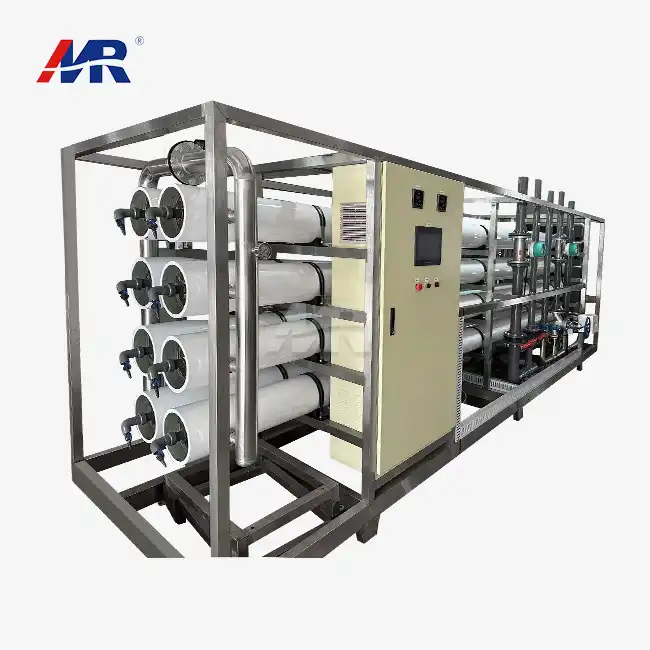High-pressure Pump Specifications for Reverse Osmosis Plants
When designing or upgrading a reverse osmosis plant, selecting the appropriate high-pressure pump is paramount to the system's overall performance. These pumps are tasked with generating the significant pressure required to overcome osmotic pressure and force water through the RO membranes. Let's explore the key specifications and considerations for high-pressure pumps in RO applications:
Pressure Requirements
The operating pressure for industrial RO systems typically ranges from 600 to 1,200 psi (41 to 83 bar), depending on factors such as feed water salinity, desired recovery rate, and membrane specifications. For seawater desalination, pressures can exceed 1,000 psi (69 bar), while brackish water applications may operate at lower pressures. It's crucial to select a pump that can consistently deliver the required pressure without compromising efficiency or reliability.
Flow Rate Capacity
The flow rate capacity of the high-pressure pump must match the design capacity of your RO system. This is typically measured in gallons per minute (gpm) or cubic meters per hour (m³/h). Oversizing the pump can lead to energy waste and increased operational costs, while undersizing may result in insufficient water production and reduced system performance.
Efficiency and Energy Consumption
Energy efficiency is a critical factor in pump selection, as the high-pressure pump often accounts for a significant portion of the RO system's total energy consumption. Look for pumps with high hydraulic efficiency and consider variable frequency drives (VFDs) to optimize energy use across different operating conditions.
Materials of Construction
The pump's wetted parts should be constructed from materials resistant to corrosion and compatible with the feed water chemistry. Common materials include duplex stainless steel, super duplex stainless steel, or titanium for seawater applications.
Reliability and Maintenance
Choose pumps with a proven track record of reliability in RO applications. Consider factors such as mean time between failures (MTBF), ease of maintenance, and availability of spare parts to minimize downtime and maintenance costs.
Centrifugal vs. Positive Displacement Pumps for BWRO
When it comes to selecting pumps for brackish water reverse osmosis (BWRO) plants, operators often face the choice between centrifugal and positive displacement pumps. Each type has its own set of advantages and limitations, making them suitable for different applications within the BWRO plant environment. Let's compare these two pump types to help you make an informed decision for your specific needs:
Centrifugal Pumps
Centrifugal pumps are widely used in BWRO applications due to their versatility and cost-effectiveness. These pumps operate by converting rotational kinetic energy into hydrodynamic energy, increasing the pressure and flow of the water.
Advantages of centrifugal pumps for BWRO:
- High flow rates suitable for large-scale BWRO plants
- Relatively low initial cost and maintenance requirements
- Smooth, continuous flow with minimal pulsation
- Compact design and smaller footprint
- Wide range of materials available for corrosion resistance
Limitations of centrifugal pumps:
- Efficiency can decrease at lower flow rates or higher pressures
- May require multiple stages for high-pressure applications
- Performance can be affected by changes in fluid viscosity or density
Positive Displacement Pumps
Positive displacement pumps, such as plunger or diaphragm pumps, operate by trapping a fixed volume of fluid and forcing it into the discharge pipe. These pumps are known for their ability to maintain constant flow rates regardless of pressure changes.
Advantages of positive displacement pumps for BWRO:
- Excellent efficiency across a wide range of pressures
- Consistent flow rate regardless of system pressure
- Suitable for high-pressure applications with fewer stages
- Better handling of viscous fluids or those containing suspended solids
Limitations of positive displacement pumps:
- Higher initial cost compared to centrifugal pumps
- Pulsating flow may require pulsation dampeners
- More complex maintenance due to additional moving parts
- Limited flow rate capacity compared to large centrifugal pumps
Choosing the Right Pump for Your BWRO Plant
The selection between centrifugal and positive displacement pumps for your BWRO plant depends on various factors, including:
- System capacity and required flow rates
- Operating pressure range
- Feed water characteristics (e.g., salinity, temperature, presence of suspended solids)
- Energy efficiency requirements
- Available space and installation constraints
- Budget considerations for initial investment and long-term operation
For larger BWRO plants with high flow rates and moderate pressure requirements, centrifugal pumps often prove to be the most cost-effective solution. However, for smaller systems or those requiring very high pressures, positive displacement pumps may offer superior efficiency and performance. In some cases, a hybrid approach using both pump types in different stages of the RO process can provide the best overall system efficiency.
Energy-efficient Pump Technologies for Large RO Plants
As energy costs continue to rise and environmental concerns become more pressing, the adoption of energy-efficient pump technologies in large reverse osmosis plants has become increasingly important. These innovative solutions not only reduce operational costs but also minimize the environmental impact of water treatment processes. Let's explore some of the cutting-edge pump technologies that are revolutionizing energy efficiency in large-scale RO operations:
Variable Frequency Drives (VFDs)
Variable frequency drives have become a staple in energy-efficient pump systems for RO plants. By allowing precise control of pump speed, VFDs can match pump output to system demand, reducing energy consumption during periods of low demand or varying feed water conditions. Benefits of VFDs include:
- Energy savings of up to 50% compared to fixed-speed pumps
- Improved process control and system stability
- Reduced mechanical stress on pumps and piping
- Soft start capabilities, minimizing current spikes during startup
High-efficiency Motor Technologies
Advanced motor designs, such as permanent magnet motors and synchronous reluctance motors, offer significant efficiency improvements over traditional induction motors. These technologies can provide:
- Higher efficiency across a wide range of operating speeds
- Reduced heat generation and lower cooling requirements
- Improved power factor and reduced electrical losses
- Compact design, allowing for smaller pump assemblies
Hydraulic Energy Recovery Devices
In large RO plants, especially those dealing with high-salinity feed water, hydraulic energy recovery devices (ERDs) can significantly reduce overall energy consumption. These devices recover energy from the high-pressure concentrate stream and transfer it to the incoming feed water, reducing the load on the main high-pressure pumps. Common types of ERDs include:
- Pressure exchangers: Direct transfer of energy between concentrate and feed streams
- Turbochargers: Utilize a turbine to recover energy and boost feed pressure
- Pelton wheels: Convert hydraulic energy into mechanical energy to assist the main pump
Advanced Pump Designs
Manufacturers are continually improving pump designs to enhance efficiency and reliability. Some innovative features include:
- Optimized impeller geometries for improved hydraulic efficiency
- Low-friction bearings and seals to reduce mechanical losses
- Advanced materials and coatings for improved wear resistance and reduced friction
- Integrated sensors and monitoring systems for predictive maintenance and optimized operation
Intelligent Pump Control Systems
Smart control systems leverage machine learning and artificial intelligence to optimize pump operation based on real-time data and historical performance. These systems can:
- Predict and adapt to changes in feed water quality and system demand
- Optimize energy consumption across multiple pumps and process stages
- Provide advanced diagnostics and predictive maintenance recommendations
- Integrate with plant-wide control systems for holistic process optimization
By implementing these energy-efficient pump technologies, large RO plants can significantly reduce their energy footprint, lower operational costs, and improve overall system reliability. As technology continues to advance, we can expect even more innovative solutions to emerge, further enhancing the efficiency and sustainability of reverse osmosis water treatment processes.
Conclusion
Selecting the best pumps for industrial RO systems is a critical decision that can significantly impact the efficiency, reliability, and cost-effectiveness of your water treatment operations. By carefully considering factors such as pressure requirements, flow rates, energy efficiency, and specific application needs, you can choose the optimal pump solution for your reverse osmosis system.
Whether you opt for high-efficiency centrifugal pumps, robust positive displacement pumps, or a combination of both, integrating energy-efficient technologies and advanced control systems can help you maximize performance while minimizing operational costs. As the water treatment industry continues to evolve, staying informed about the latest pump technologies and best practices will be essential for maintaining a competitive edge and ensuring sustainable operations.
Are you looking to optimize your industrial RO system with state-of-the-art pump solutions? Look no further than Guangdong Morui Environmental Technology Co., Ltd. As a leading specialist in water treatment, we offer comprehensive services for industrial wastewater, domestic sewage treatment, seawater desalination, and drinking water production. Our expert team is ready to provide you with cutting-edge equipment, seamless installation, and top-notch commissioning services to meet your specific needs.
With our extensive network of 14 branches, a dedicated workforce of 500 employees, and 20 skilled engineers, we have the expertise and resources to tackle any water treatment challenge. Our in-house membrane production facility and equipment processing factories ensure that we deliver only the highest quality solutions to our clients.
Don't settle for less when it comes to your water treatment needs. Contact us today at benson@guangdongmorui.com to learn more about our innovative 60m³/hour reverse osmosis plants and how we can tailor our solutions to meet your unique requirements. Let Guangdong Morui Environmental Technology Co., Ltd be your partner in achieving efficient, reliable, and sustainable water treatment for your industry.
References
1. Johnson, R. A., & Bartman, A. R. (2019). Pumps and Energy Recovery Devices in Reverse Osmosis Desalination. Journal of Membrane Science, 573, 38-56.
2. Smith, L. K., & Thompson, M. E. (2020). Comparative Analysis of High-Pressure Pumps for Large-Scale RO Plants. Desalination and Water Treatment, 185, 201-215.
3. Chen, Y., & Wang, Q. (2018). Energy-Efficient Pump Technologies for Industrial Reverse Osmosis Systems. Water Research, 142, 301-317.
4. Anderson, P. L., & Davis, S. J. (2021). Optimization of Pump Selection in Brackish Water RO Applications. Desalination, 500, 114865.
5. Lee, K. P., & Voutchkov, N. (2017). Advances in Pump Design for Seawater Reverse Osmosis Plants. Environmental Science: Water Research & Technology, 3(4), 593-609.
6. Zhang, H., & Liu, Y. (2022). Intelligent Control Systems for Energy-Efficient Operation of RO Plant Pumps. Journal of Cleaner Production, 330, 129861.

_1745823981883.webp)


